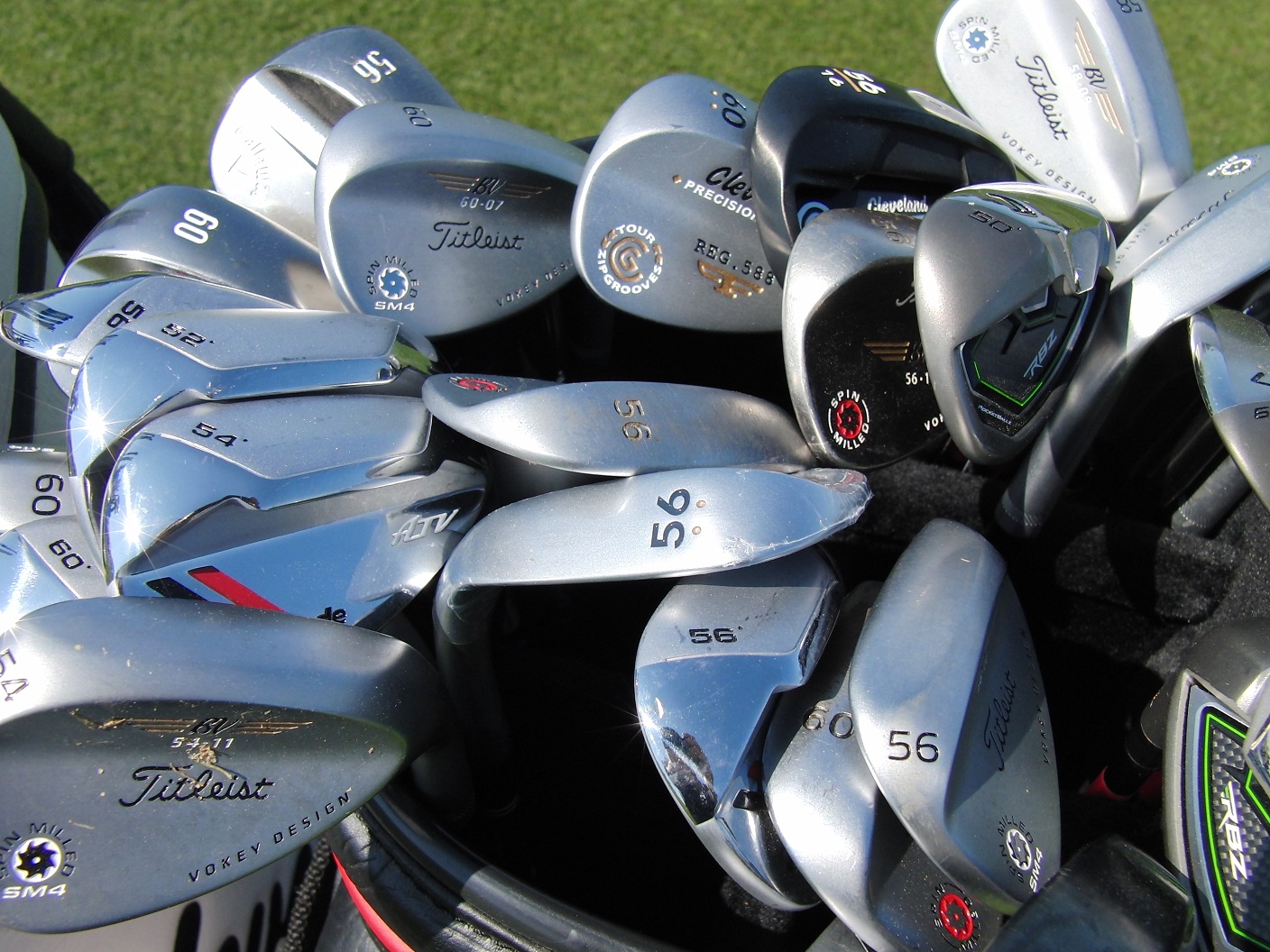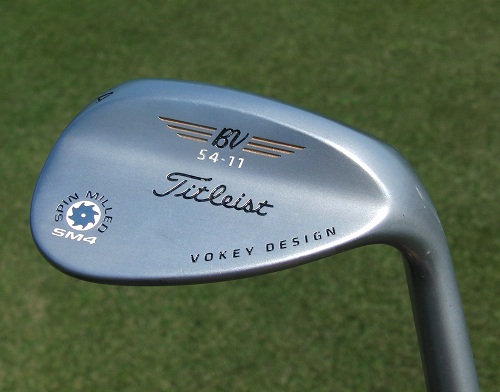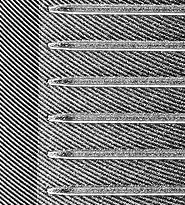The Science Behind Superb Wedges: Part II
/ In my quest to better understand pitching, chipping, and more specifically the low spinning wedge shot I needed to watch different professional players hit a variety of shots and be able to track the data from each shot. My objective was to understand how friction or grip between the face and the ball influenced the launch angle, height and spin rate. I have named the measurement of this grip and it's influence on the golf ball - friction launch.
In my quest to better understand pitching, chipping, and more specifically the low spinning wedge shot I needed to watch different professional players hit a variety of shots and be able to track the data from each shot. My objective was to understand how friction or grip between the face and the ball influenced the launch angle, height and spin rate. I have named the measurement of this grip and it's influence on the golf ball - friction launch.
I need to explain some fairly detailed physics as to how I measure friction launch, so bear with me. The golf ball always launches somewhere between where the face is angled and where the clubhead is travelling - on both a vertical and horizontal plane. The ball also always launches closer to where the face is angled than where the clubhead is travelling. Where the ball launches between the face angle and the clubpath is primarily determined by club speed and friction between the face and ball. I needed to measure this friction in order to see how it effected the trajectory and spin on wedge shots.
With the help of Mark Reilly and Edoardo Molinari, we came up with the following formula to determine friction launch:
(Dynamic Loft - Launch Angle) x 100/Spin Loft = Friction Launch
This formula informs us where the ball launches between the face and path. The percentage indicates how far below the face angle the ball launched. A friction launch of 0% indicates that there was absolutely no grip at impact and the ball launched in the direction the face was angled at impact. A friction launch of 50% would indicate that the ball launched directly between the face angle and the clubpath and the grip was exceedingly high. By the way - neither of these are possible under normal conditions. The smaller the percentage, the higher the launch and lower the spin and vice versa.
With all the various situations I tested I needed to keep certain factors constant in order to be able to detect why the trajectory and spin rate of each shot was altered. My constants were TrackMan - to record the data; the golf club - a Titleist Vokey SM4 54 degree wedge; and the distance of each shot studied - 50 yards. If any ball landed short of 40 yards or longer than 60 yards it's data was thrown out. The factors I controlled were the quality of the lie and playing surface, the grass and dirt in the grooves and on the face and the type of golf ball.
Here are the average results attained from three professional golfers hitting 10 shots each in 7 different situations:
1. Clubface packed with dirt and grass/ProV1/off lie board (to eliminate additional matter)
- Friction Launch 17.9 degrees/Spin Rate 4408/Launch Angle 34.9 degrees/Height 31.9ft/Carry 51.6yds
2. Clean clubface/ProV1/off lie board (to eliminate additional matter)
- Friction Launch 28.1 degrees/Spin Rate 6501/Launch Angle 28.4 degrees/Height 25.1ft/Carry 50.3yds
3. Wet clubface/ProV1/off lie board (to eliminate additional matter)
- Friction Launch 28.1 degrees/Spin Rate 6564/Launch Angle 28.7 degrees/Height 25.7ft/Carry 50.4yds
4. Clean clubface/ProV1/off turf/preferred lie
- Friction Launch 31.9 degrees/Spin Rate 7178/Launch Angle 26.1 degrees/Height 22.3ft/Carry 48.9yds
5. Clean clubface/hard range ball/off turf/preferred lie
- Friction Launch 28.8 degrees/Spin Rate 6625/Launch Angle 27.6 degrees/Height 25.1ft/Carry 50.8yds
6. Clean clubface/ProV1/off a new mat
- Friction Launch 30.4 degrees/Spin Rate 6859/Launch Angle 26.8 degrees/Height 23.3ft/Carry 49.2yds
7. Clean clubface/ProV1/Off a tee
- Friction Launch 30.6 degrees/Spin Rate 7259/Launch Angle 27.6 degrees/Height 24.8ft/Carry 51.2yds
Edoardo Molinari was also kind enough to submit his TrackMan data to me from the 10 shots he hit with his 60 degree wedge and 10 more with his 56 degree wedge: (the following shots were hit with premium golfballs, off preferred lies and cleaning the clubface between each shot)
60 Degree Wedge
- Friction Launch 22.9 degrees/Spin Rate 6048/Launch Angle 36.2 degrees/Height 34.8ft/Carry 51.0yds
56 Degree Wedge
- Friction Launch 24.4 degrees/Spin Rate 6046/Launch Angle 34.2 degrees/Height 31.5ft/Carry 50.5yds
NOTE: After a few weeks of practice Edoardo has improved his 10 shot average with his 60 degree to a spin rate of 8700rpm and a Launch angle of 26.1 degrees! There is something to this...
The deductions I took from the above tests are as follows:
- Shots out of the rough, first cut or even into the grain lies are always going to launch higher, spin less and as a result fall out the sky faster and roll more after landing - no matter how good you or your wedge is. There simply is too much 'matter' involved between face and ball to create optimal friction.
- A wet clubface actually makes very little difference in determining how much friction, and thus spin, is imparted on the ball.
- A premium golfball makes a noticeable difference with the wedges. Not only will it add distance off the tee, but it will also allow you to hit better and more predictable short shots.
- If the rules allow you to tee the ball up - go ahead and do so. You increase your ability to place the clubface cleanly on the back of the golf ball.
- Hitting pitch shots off mats is a fantasy world and can only increase the 'illusion of competence'. No bad lies, nothing between the face and the ball, minimal consequence to heavy shots...
- For pitch shots, higher lofted clubs do not spin the ball significantly more than the next wedge down (60*vs56*). They do, however, get the ball to stop slightly faster due to a steeper landing angle.
- Average friction launch for a 50 yard shot is around 25%. The lowest friction launch was out of the poorest lie (18%) and the best results came from an ideal fairway lie, a new and clean wedge along with a premium golfball (32%).
- The quality of the lie is the most important factor in allowing a golfer to control the trajectory and spin of the wedge shot they are about to play.
Let's take a look at the factors that influence friction launch:
The Golf Club
- The sharpness of the top edge of the groove will effect spin, yet most of the spin on a shot comes from the roughness of the area between the grooves.
- In my opinion the wedges that provide the highest amount of spin are the models that have the roughest surface between the grooves - the new TaylorMade ATV and the Nike Vr Pro wedges seem to do an excellent job with 'between groove' treatment.
- An excellent way to improve spin with your current wedges is to have the face sandblasted with normal aluminum oxide sand. This will provide a rougher, more 'grippy' texture to the face.
- The number of groove edges that come into contact with the ball also effects backspin. In pushing the limit of the groove rules manufacturers can now put five grooves on the surface of the ball at impact versus the traditional three.
- Grooves channel away some of the moisture and matter from rough that gets between the ball and face - but seldom all of it.
- The grooves and face of your wedges should always be very clean - even when you're practicing. Keep a towel or brush handy to clean the club after every few shots.
- If you are serious about competitive golf I would recommend having a tournament set of wedges and a set you use in practice. Every shot you hit wears down the face which reduces friction at impact.
- In fact Gary Player would ensure that his caddie never cleaned his wedge after hitting a sand shot - the sand particles on the face helped to create more friction between the face and ball for his next shot.
Turf Type and the Quality of the Lie:
- When you are into the grain you will often get grass caught between the ball and the face, thus reducing grip. A down grain shot will 'cut' very little grass and thus allow for clean contact and increased grip.
- Different turf types are thicker and stronger and thus, even at fairway height, support the ball enough to keep it up and away from the grass. This makes it easier to have a higher friction launch factor. If you've ever played off kikuyu grass you'll know what I mean.
- When laying up on a par five understand the value of high friction launch - lay up in the fairway and don't be greedy.
The Swing
- This is where I am now focusing my efforts. There does seem to be a method that DOES NOT involve a more open face, increased speed, higher launch or a cutting action that seems to produce a lower trajectory with a much higher spin rate. Stay tuned.....
Read part one of this article HERE










